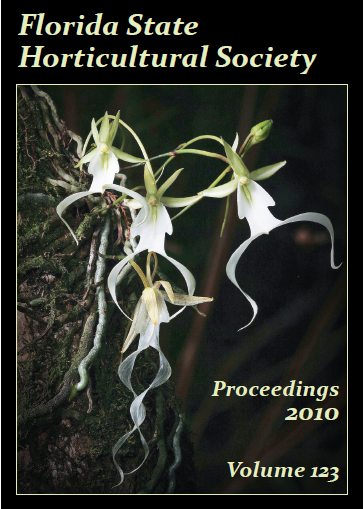Citrus
Variation in Florida Orange Yields Over a 37-Year Period: A Standardized Evaluation
Published 2010-12-01
Keywords
- mature tree equivalents,
- early-mid season,
- Flatwoods,
- freeze,
- hurricane
- late-season,
- Ridge ...More
Abstract
To monitor changes in Florida orange production per mature tree over time, a method was devised to standardize the number of bearing trees each year to account for variation in the number of mature and young bearing age trees which have lower yields than mature trees. This was accomplished by estimating young tree production as a percentage of mature tree yields and adjusting values in each year to reflect mature tree equivalents (MTE). Orange trees in Flatwoods areas were assigned partial values for their yield potential from 5 until 10 years of age compared to mature tree yields, and young trees in Ridge areas were assigned partial mature tree values from age 5 until 13 years of age depending on studies of yield to tree age in these two major production areas. MTE values were divided into the reported annual yields of early-midseason (E-M) (primarily ‘Hamlin’) and late (primarily ‘Valencia’) orange cultivars. Freeze events were also rated for severity and all these values, including total Florida citrus yield in boxes are reported in graphic form for the years 1963 through 1999. Excepting 1964, early‑midseason orange yields ranged from 2.7 to 5.5 boxes/MTE and late orange yields ranged from 2.3 to 4.4 boxes/MTE for the period 1963 through 1999. There was an increase in productivity per tree from 1963 until 1970 with no perceptible increase after that. Comparing MTE yields in 2008, 3 to 4 years after the 2004–05 series of hurricanes indicated that Ridge yields were similar to pre-hurricane yields, but yields in Flatwoods areas were low. These results can be useful for evaluating trends in yields over time, the impact of weather events and assessing yield potential from predicted and actual levels of bloom each year.References
- Albrigo, L.G., C.A. Anderson, G.J. Edwards, F.W. Bistline, W.J. Hepburn, and T. Cary. 1975. Yield estimation of ‘Valencia’ orange research plots and groves. Proc. Fla. State Hort. Soc. 88:44–49.
- Albrigo, L.G., H. Beck, and J.I. Valiente. 2006. Testing a flowering expert system for the ‘Decision Information System for Citrus’. Proc. 7th Symp. Modeling in fruit research and orchard management. Acta Hort. 707:17–24.
- FASS. 1984. Commercial citrus inventory. Florida Dept. Agr. and Consumer Serv., Florida Agr. Stat. Serv., Orlando.
- Koo, R.C.J. and J.W. Sites. 1955. Results of research and response of citrus to supplemental irrigation. Proc. Soil Sci. Soc. Fla. XV:180–190.
- Reitz, H.J. and R.C.J. Koo. 1959. Effect of nitrogen and potassium fertilization on yield, fruit quality and leaf analysis of ‘Valencia’ orange. Proc. Fla. State Hort. Soc. 72:12–16.
- Reuther, W., P.F. Smith, G.K. Scudder, Jr., and F. Hrnciar. 1957. Responses of Valencia and Hamlin orange trees to timing, rates, and ratios of nitrogen fertilization. Proc. Amer.Soc. Hort. Sci. 70:223–236.
- Roka, F.M., R.E. Rouse, and R.P. Muraro. 1997. Southwest Florida citrus yield by tree age in high density plantings. Proc. Fla. State Hort. Soc. 110:82–86.
- Savage, Z. 1960. Citrus yields per tree by age. Econ. Ser. 60-8, Food and Resource Econ. Dept., Univ. Florida, Gainesville.
- Sites, J.W. and E.J. Deszyck. 1952. Effect of varying amounts of potash on yield and quality of Valencia and Hamlin oranges. Proc. Fla. State Hort. Soc. 65:92–98.
- Smith, P.F. 1954. Boron deficiency in Florida citrus groves. Proc. Fla. State Hort. Soc. 67:69–73.
- Stewart, I. and C.D. Leonard. 1962. Effect of various salts on the availability of zinc and manganese to citrus. Soil Sci. 95:149–154.

